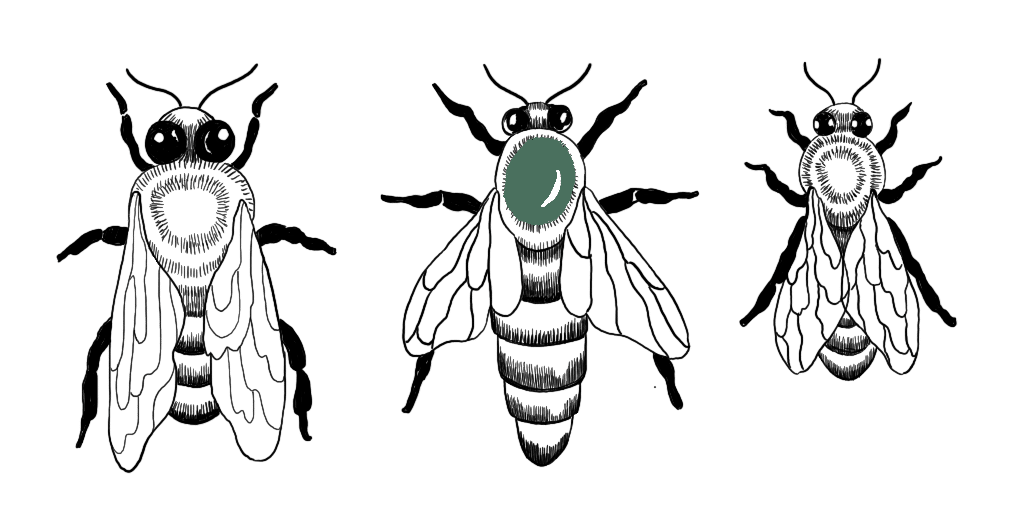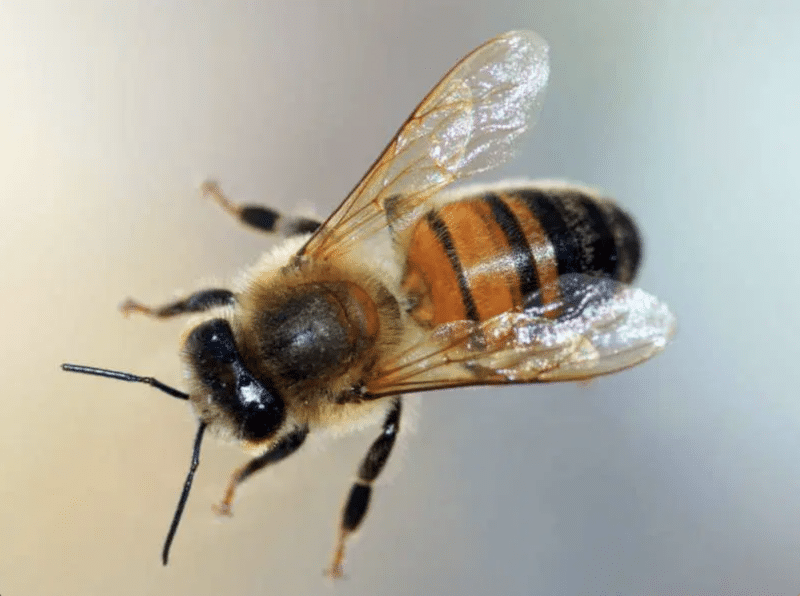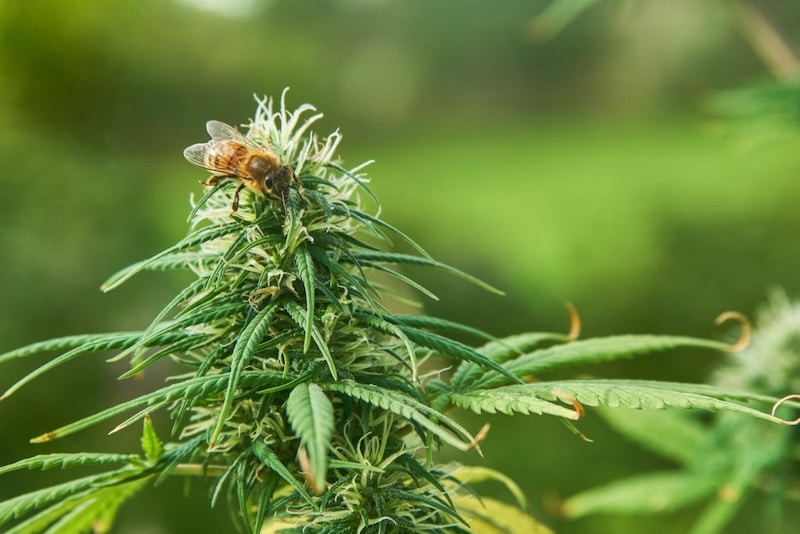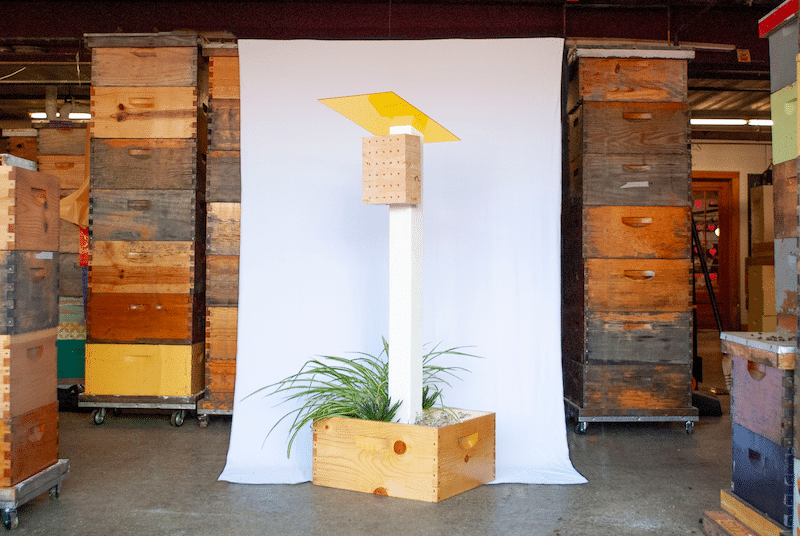Contents
What are the different types of bees and their roles in a beehive?
There are three levels to the hierarchy of the beehive — queens, worker bees, and drones — and each has a distinctive role or roles to play within a hive.
–– Interested to know how the bees are doing? Download our State of the Honey Bee Report now ––
Queens
- Egg laying
- Regulating hive activity and well-being
- Swarming
Drones
- Reproduction through mating with virgin queens outside the hive
Worker Bees
- Cleaning
- Nursing
- Queen attendance
- Comb building
- Nectar & pollen reception
- Pollen packing
- Nectar ripening
- Comb capping
- Hive repair
- Temperature regulation
- Hive defense
- Food and water foraging
- New hive site foraging
What does a queen bee do?
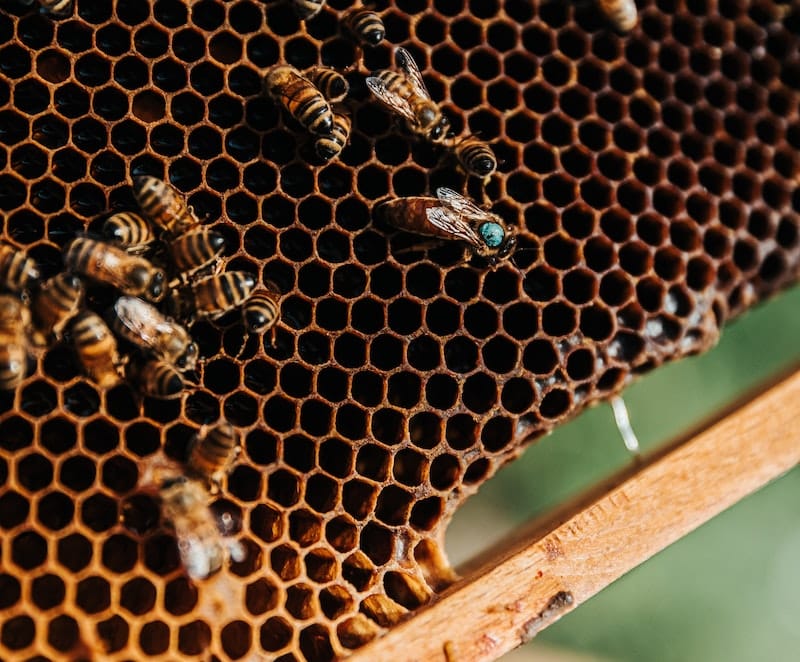
Quick Facts about queens:
- Queens have three roles in the hive: egg-laying, hive regulating and swarming.
- Queens live for an average of 1-2 years.
- Until a hive is ready to divide and swarm, there is only one queen.
- Queen pheromones give each hive a distinct scent, recognized by the colony.
The queen bee has three essential roles in the hive: 1) she lays eggs; 2) she regulates the activity of the hive through pheromones she emits. Pheromones are chemicals produced and released into the air by bees, affecting the behavior and physiology of other bees in the hive; and 3) she signals the time to swarm, leaves the hive in the company of half the worker bees, contains the swarm, and, once safely situated, starts laying eggs for a new colony.
Queens are the only fully developed females, and after mating with the drones, lay all the eggs for the hive.
Queens exude Queen Mandibular Pheromones (QMP) — unique scents that personify each hive, and tell worker bees if she is healthy, or needs replacement. The stronger the scent, the more attendants she has. QMB stimulates comb construction, brood rearing, foraging, and food storage. The queen’s pheromones also prevent female worker bees from developing reproductive capabilities. When she dies, the drop in QMP signals worker bees to create new queens to replace her.
When colonies become congested or too large to be managed by one queen, worker bees create new queens, and the old queen stops laying eggs and leaves with approximately half of the hive to form a new colony. This flight of a tightly formed cloud of bees is called a swarm. The queen’s pheromones help to keep the swarm together in a cluster when resting, while forager bees find a safe place for the colony to establish its new home.
To learn more about the duties of queens, read our blog “The Role of a Queen Bee in a Hive”.
What does a drone bee do?
Quick Facts about drones:
- Drones are the only males in a hive.
- Drones play only one role: reproduction.
- Drones are larger than worker bees but smaller than queens.
- Drones represent 10-15% of the hive’s population.
- Drones have no stingers.
- No drones survive the winter.
Drones are produced when the hive is healthy and has a surplus of food and workers. This corresponds with swarming season — from the end of April through June in northern areas of the US. Drones are created by unfertilized eggs, laid by queens in larger brood cells. They are Haploid organisms, meaning they inherit only one set of chromosomes. Queens and worker bees are diploid organisms — they inherit chromosomes from both the queen and a mating drone.
Drones represent about 15% of colony populations, and their sole function is reproduction. Once hatched and fully matured, they fly away from the hive to places high in the air known as drone congregation areas, where drones from many different hives await virgin queens to mate with. Successful drones die after mating; the rest return to their hives where they are fed by worker bees until the end of the summer. At that point, they are pushed out of the hive so that food stores can be reserved for the queen and the worker bees that will feed, warm, and protect her throughout the winter. Drones starve or freeze after ejection; none survive until spring.
What is a worker bee?

Facts about worker bees:
- Worker bees are female bees that do not reproduce.
- Worker bees live for an average of 5-7 weeks.
- Worker bees represent 80-99% of the colony population.
- Worker bees can play more than a dozen specialized rolls inside and outside the hive, from cleaning to honey producing to foraging.
They are the smallest of the three types of bees. Worker bees have stingers and will use them to defend themselves and their hive. They come in a variety of colors and patterns, which are determined by the drones the queen has mated with. During the warm months, most worker bees live for just 5-6 weeks. Those that stay to protect, warm, and feed the queen can live for an additional 3-5 months, depending on the length of winter.
How do worker bees get their roles and jobs?
Worker bees take three weeks to develop from egg to bee, and live for 5-7 weeks. During the course of their brief lives, their roles change, based on their age and the needs of their hive.
The process from egg-laying to hatching as a worker bee takes 21 days. After 3 days, the egg changes into a larva, and its brood cell is capped 6 days later, when it becomes a pupa. After 12 days as a pupa, she hatches, emerging as a functioning worker bee.
After hatching, a worker bee can play many roles in a hive. Her transition through different roles throughout the course of her life is called polyethism.
For approximately 15 days, the worker bee will stay inside, tending to hive functions. At first, she will focus on cleaning and queen attendance. Around day 12, special wax-producing glands fully develop, and she may move on to comb production and other jobs related to food storage, such as pollen and nectar reception, nectar ripening and comb packing and capping.
As she ages, different hormones in her body will increase and decrease. A decrease in vitellogenin protein and increase in Juvenile Hormone transitions her to be ready to move out of the hive, and take up new tasks as a field bee, such as guarding and forging.
Conditions within and outside the hive can affect the pace of her transition. If more foragers are needed, nurse bees can transition to field bees; if more care is needed within the hive, field bees can transition back into hive bees. External factors like the number of foragers and newly emerged bees, the amount of brood in the colony, and how much pollen the hive has stored also influence this transition.
Different jobs of worker bees within a hive:

Cleaning
The first task of a house worker bee is to clean her cell and the area around it. Then, she moves on to help clean and polish empty cells and rid the hive of dead bees and excrement. House bees also clean other bees in the hive, removing dust, hairs and debris from their bodies.
Nursing
The next job of a house bee is to feed, clean, cap the brood (organisms in cells developing from egg to larva to pupa that will hatch into honeybees), and keep the brood warm.
Attending the queen
Some house bees become attendants to the queen. They follow her through the hive as she lays eggs, feeding, watering, cleaning, and grooming her.
Building honeycomb
After 12 days, worker bees have developed specialized glands that produce wax. If needed, they will take on this role, building the foundation for combs and then the combs themselves.
Receiving pollen and nectar
Receiving food from field bees is a specialized job that many house bees take on so that field bees can return as quickly as possible to forage for more food and water. Some bees scrape the pollen off foragers’ legs for transfer to storage cells. Others receive nectar that is regurgitated by the foragers, and pass it on to other receiving bees, who continue this process of consumption and regurgitation until the fluid is reduced to about 20% of its original volume. In each step, the receiving bees add enzymes, further breaking down the sugars.
Pollen packing
Once pollen has been scraped off forager bees, house bees take and pack it into empty cells, adding enzymes and acids they secrete to keep it from spoiling. This substance is known as “bee bread” and is the hives’ primary source of protein, vitamins and minerals.
Nectar ripening
After nectar has been received and placed into honeycomb cells, other worker bees fan the top of the cells to speed evaporation, eventually reducing the nectar to 18% of its original volume. This creates the thick, sweet, fluid we call honey.
Comb capping
When cells are filled with honey, worker bees cap them with wax sealing the honey inside to prevent further evaporation and infection by pathogens.
Hive repair
Bees use propolis — the resin collected by forager bees, also known as “bee glue” — to repair cracks in the hive and to cover foreign elements too large to remove.
Ventilation and temperature regulating
On hot days, worker bees stand at the front door and fan air into the hive, to cool it down. In winter months, they form a ball around the queen using their collective body warmth to protect her. Worker bees take turns cycling from the inside of the mass of bees to the outside, acting as living insulation, then warming back up as a new layer replaces them.
Dead bee removal
While most bees die outside the hive, about 10% die within the hive and are pushed out of the hive by cleaner bees. After they’ve dried, undertaker bees pick them up and fly them hundreds of feet away from the hive, as dead bees can attract pests and pathogens.
Guarding
Guard bees protect the hive by attacking and, if needed, stinging intruders. They also emit pheromones that warn bees inside the hive of danger.
Foraging
Field bees forage for food, water, and resin.
The majority of field bees forage for food — both nectar and pollen, which they carry in “pollen baskets” on their legs. Forager bees can visit 50-100 flowers on each flight and can make 10 flights a day. They drink the nectar and store it in a special nectar stomach, where enzymes break down complex sugars, turning them into simple sugars that are less prone to crystallization and fermentation.
About 1% of bees forage for water. Water is consumed by hive bees, fed to the queen, and used to dilute honey to make a solution which can be fed to the larvae. It’s also used to cool the hive.
A small portion of field bees forage for resin, which is converted in the hive into propolis. Worker bees then use propolis to make repairs on the hive.
Foraging for new sites
In the event of swarming, some field bees will forage for a new site, searching the area for a safe place, such as a hollow tree, to bring the swarm and start a new colony.
FAQs
Q: What are the roles in a beehive?
A: There are three types of bees in a beehive — the queen, drones and worker bees — and each plays unique roles in the creation and maintenance of the colony. Queens lay eggs, regulate hive activity through emission of pheromones, and instigate swarming that forms a new hive. Drones have only one role: mate with virgin queens. Worker bees have many roles, including hive cleaning & repair, brood nursing, queen attending, comb building, foraging for food and water, creating and storing honey, and guarding the hive from intruders.
Q: Do worker bees’ roles change during their lives?
A: Worker bees take on different roles during their short, 5-7 week lives. For the first 15 days they work inside the hive as “house” bees, cleaning, nursing, building combs, etc. For the second half of their lives, they usually work outside the hive as “field” bees, guarding the hive and foraging for food and water.
Q: How do worker bee roles change?
A: As worker bees age, their bodies change physically and chemically, giving them different abilities and purposes.
Q: Does every worker bee go through the same set of jobs, at the same pace?
A: While there’s a common pattern to worker bee roles in all honeybee hives, what individual bees will do, and the pace of change, can vary from hive to hive based on internal and external conditions within each hive. Damage to the hive can cause more bees to work on hive repair; an abundance of nectar can cause more bees to stay in the hive to build combs and make honey; a lack of successful foraging can cause house bees to transform into field bees to help find scarce food.
Q: Do house and field bees ever interact?
A: House bees that are assigned to receive nectar and pollen scrape the pollen off returning field bees and drink their regurgitated nectar.
Q: Do queens have any job other than egg-laying?
A: Queens emit pheromones that give each hive, and the bees within it, a distinct chemical profile that tells returning bees that they’re home and lets guard bees know if an intruder is present. These pheromones also signal hive health to worker bees, causing them to change roles as needed. The reduction in pheromones, or the death of a queen, signals to worker bees the need to create new queens. Queens also instigate swarming, the process where the queen and half the hive leave to start a new colony.
Q: Do drones do anything but mate with queens?
A: No, drones are good only for mating. They can’t forage for food, or even feed themselves. In the winter, they’d be a drain on the food resources of the hive, so they are driven out of the hive in the fall to starve or freeze to death. New drones are created each spring by the queen.


